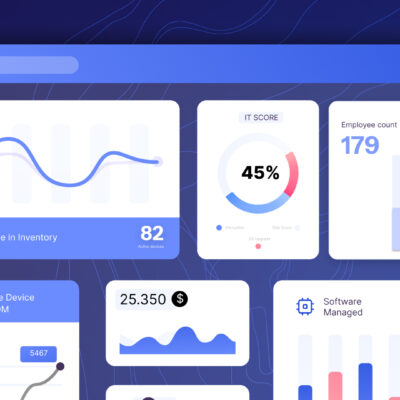How to Create Time-Saving Business Automations
Automation has quickly risen to the top of the priority list for startups and small enterprises. Entrepreneurs can greatly benefit from automation in terms of competitive advantages. According to current estimates, 25% of owners spend their time engaging in machine-related activities.
With CIOs and their teams accepting automation rather than viewing it as a threat, widespread methods of automation have surfaced. But what if your business is still heavily — if not completely — dependent on antiquated, manual procedures? It can be difficult to begin taking the initial, meaningful steps toward expanding automation.
We can help you with just that. Here are some ways to benefit financially from automation especially if you are unsure of how to get started.
How to Start Automating Your Business

1. Start with the Most Frequent and Complex Processes
It makes more sense to start with the easy stuff and work up to the difficult ones. However, it’s best to reverse the process when it comes to IT and business automation. By automating business operations that take up too much time for your personnel, the organization gains more time and is more motivated to keep working on these tasks.
The gathering of customer data to determine a customer’s loan eligibility is a perfect example of a business process being automated. It is a fundamental procedure for financial organizations and is essential for any upcoming projects.
Requests could be processed more rapidly thanks to automation, which helps employees save time and gives customers more for their money. Everyone would rather have their loan request completed in 30 minutes rather than a week.
Making your website compatible with third-party services is another great example of automation for a digital business. With the use of systems like the ones that ZenAdmin sets, internal and external processes can be sped up by huge margins.
2. Create an Organization Before Automating
Business analysts and IT specialists can greatly improve the automation of business operations. If automation is hurting more than one department, then each department should have its own representation. In order to achieve optimal effectiveness, this will bring the automation process as close to how actual people do the work.
The technical specifications for the smooth operation of robots must be developed by an Enterprise Resource Planning (ERP) system development company, and business analysts must be responsible for automating the tasks that are most crucial to the business to produce advantages that outweigh the costs.
3. Have Employees Understand the Value of Automation
It’s critical to understand that IT and AI serve as employees’ assistants, not as their replacements. If workers are aware of this, any anti-IT employees won’t be concerned that their work will obstruct modernization.
Even widespread automation does not always result in workforce cutbacks because businesses often move individuals into positions with more business relevance. In the course of their work, the majority of employees do not want to repeat the data of 100 customers in 10 different programs and files. A program might greatly simplify an employee’s life.
Employee opinions regarding the processes they think should be automated should be sought out first. Before choosing a priority list and using Robotic Process Automation (RPA) technology, it’s best to construct a list of procedures based on everyone’s feedback.
4. Automate Untested Techniques
Experts advise beginning with the RPA installation. Debugging is a process that cannot be completed as quickly as robotization or automation. Automation is already having an impact, although debugging may take months to complete. It’s likely that you’ll need to formalize the business procedures as you advance toward robotization. Once you have a comprehensive understanding of the situation as it is right now, figuring out what needs to change will be simpler.
The objectives of BPM and RPA are completely different. The first system enhances accuracy and speeds up commercial operations, whereas the second system develops sound thinking. RPA or BPM is not a matter of choice. Experience has shown that using them together is the most effective setup. However, when used independently, BPM and RPA technologies are both very effective at tackling particular issues.
Applications for RPA automation are managed by BPM platforms. Whether a person or program executes the operation is irrelevant to a BPM system. If the robot is present, BPM will gather the required information and transmit the command. The BPM obtains the data from the robot and sends it to the robot when the command has been carried out. This solves many of the problems connected with robotization and enables robots to be fully incorporated into the business process.
Process Automation Types

Business Process Automation (BPA): The use of software to carry out routine processes in place of manual labor. BPA is more concerned with automating a workflow throughout the entire organization than it is with single jobs.
Robotic Process Automation (RPA): The use of digital “robots” to automate manual, rule-based, and repetitive human tasks.
Intelligent Process Automation: A set of business process technologies called intelligent process automation imitates human actions and, over time, learns to do them better.
Advantages of Automation

There are numerous shared benefits, regardless of the automation system you use:
- Enhanced operational effectiveness: Automation allows your company to concentrate on its main goals by reducing time, effort, and expense while lowering manual errors
- Saves time: Repeated chores can be finished more quickly
- Increased consistency and quality: Process automation ensures high-quality outcomes since every activity is carried out consistently and without human error
- Improvement in employee satisfaction: Manual labor is tedious and boring. Automation boosts employee satisfaction by enabling them to work on more interesting tasks
- Improved client satisfaction: Customer satisfaction is increased as a result of happier staff, quicker processing, and time savings that allow teams to focus on providing better customer care
Business Automation in the Digital Age

Although many organizations recognize the advantages of digitization, many of them struggle to maintain pace when implementing solutions. The primary issue has always been the high expense of creating software, which is frequently customized for each organization.
The pandemic has prompted an increasing number of firms to commit to accelerating their digital transformation initiatives. The necessity for efficiency to sustain the expansion and, in some cases, to survive is a major driving force behind this.
Automation adoption is essential for these organizations to reduce costs, boost efficiency, and raise customer and staff satisfaction. Business leaders can ensure that their digital transformation goals are being reached by automating manual procedures, which are frequently paper-based. But how can they currently overcome obstacles like cost and implementation time?
Tips on What and How to Automate Your Business

1. Be Aware of the Process Before Automation
It’s a good idea to become familiar with every phase of the process before automating it. By doing this, you can easily divide your task into smaller components, making it easier to program while also optimizing and improving it.
2. Utilize Resources to Expedite Your Workflow
You can process any data entry for your marketing efforts using a variety of free tools that you can find online. For instance, CRM for small businesses can complement your marketing initiatives and enable you to profit from them in the long run. Selecting more premium tools – while pricier – might be worthwhile, with payment rapidly covering the cost.
3. Utilize Integrated Software With Greater Capabilities
If you haven’t already, it could be time to move your company to cloud-based computer services. Numerous advantages of cloud-based computing services include frequent upgrades, integrated automation tools, and the capacity to develop with your company as it grows.
4. Spend Time on What You Do Best
It’s best to plan automation expressly for tasks that don’t relate to the core competencies of your company. The workforce for lucrative positions will receive more attention, and you’ll have more time to expand your company and enjoy success in the sector.
5. Create Leads While Maximizing Them
Sticky notes and phone calls are no longer viable means of managing and gathering leads. Utilize the resources available in this digital age to maintain the competitive nature of your business. You can generate and gather leads while nurturing them with the use of cloud-based applications or CRM platforms.
Read more about the 5 Best Practices for Cloud Management here.
6. Partner With an IT Management or Solutions Company
You may need to take several hours off work for employee onboarding and offboarding. To cut down on time-consuming IT demands that keep you from getting work done, consider partnering with an IT management solutions company like ZenAdmin.
You can quickly submit your requests for employee onboarding and offboarding using the ZenAdmin web portal. ZenAdmin uses standardized forms to ensure uniformity across all requests, with different settings you can use to tailor requests to your business needs. After your request has been submitted, ZenAdmin will take care of the rest.
Check out this Step-By-Step Guide to Onboarding Your Remote Hires here.
Make IT Easy With ZenAdmin

ZenAdmin is available to assist you with all of your IT needs, allowing you to concentrate on what’s really important – your business. Let ZenAdmin’s IT experts handle the finer issues, giving you the best IT structures and processes to support you and your company. Book a free demo session today!












